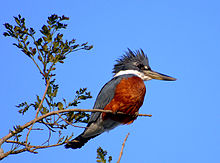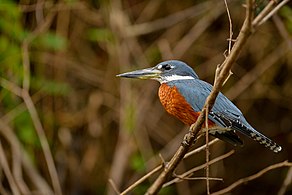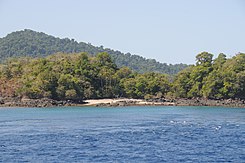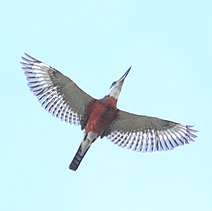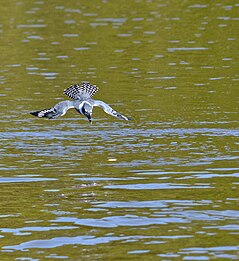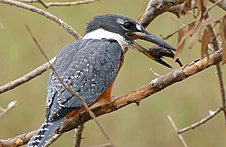
Kingfishers are a family, the Alcedinidae, of small to medium-sized, brightly colored birds in the order Coraciiformes. They have a cosmopolitan distribution, with most species found in the tropical regions of Africa, Asia, and Oceania, but also can be seen in Europe. They can be found in deep forests near calm ponds and small rivers. The family contains 116 species and is divided into three subfamilies and 19 genera. All kingfishers have large heads, long, sharp, pointed bills, short legs, and stubby tails. Most species have bright plumage with only small differences between the sexes. Most species are tropical in distribution, and a slight majority are found only in forests.
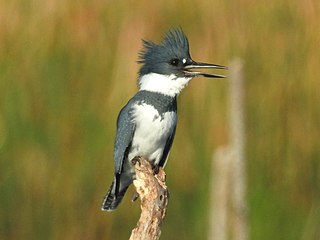
The belted kingfisher is a large, conspicuous water kingfisher, native to North America. All kingfishers were formerly placed in one family, Alcedinidae, but recent research suggests that this should be divided into three subfamilies.
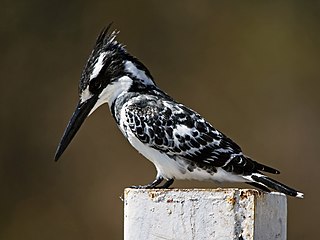
The water kingfishers or Cerylinae are one of the three subfamilies of kingfishers, and are also known as the cerylid kingfishers. All six American species are in this subfamily.

Bachman's warbler is a likely extinct passerine migratory bird. This warbler was a migrant, breeding in swampy blackberry and cane thickets of the Southeastern and Midwestern United States and wintering in Cuba. There are some reports of the bird from the twenty-first century, but none are widely accepted. Some authorities accept a Louisiana sighting in August 1988 as confirmed, but the last uncontroversial sightings date to the 1960s.
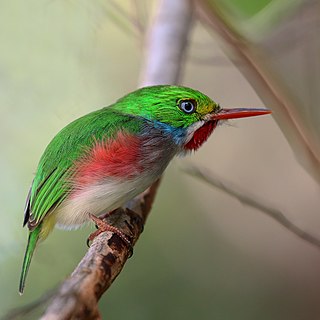
The todies are a family, Todidae, of tiny Caribbean birds in the order Coraciiformes, which also includes the kingfishers, bee-eaters and rollers. The family has one living genus, Todus, and one genus known from the fossil record, Palaeotodus.

The green-breasted mango or Prevost's mango is a species in subfamily Polytminae of the hummingbird family Trochilidae. It is found from eastern Mexico south through most of Central America, in Colombia and Venezuela, and as a vagrant in the United States.

The green kingfisher is a species of "water kingfisher" in the subfamily Cerylinae of the family Alcedinidae. It is found from southern Texas in the United States south through Central America, in every mainland South American country except Chile and Trinidad and Tobago.
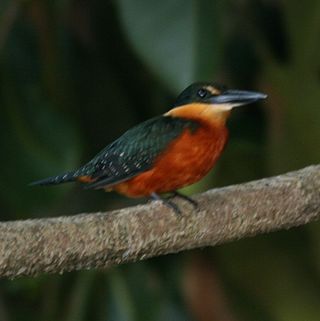
The American green kingfishers are the kingfisher genus Chloroceryle, which are native to tropical Central and South America, with one species extending north to south Texas.

Megaceryle is a genus of very large kingfishers. They have a wide distribution in the Americas, Africa, and Southeast Asia.

The white-headed buffalo weaver or white-faced buffalo-weaver is a species of passerine bird in the family Ploceidae native to East Africa. The buffalo part of its name derives from its habit of following the African buffalo, feeding on disturbed insects. Two subspecies are recognized.

Audubon's oriole, formerly known as the black-headed oriole, is a New World passerine inhabiting the forests and thickets of southeastern Texas and the Mexican coast. It is the only species to have a black hood and yellow body. It is divided into four subspecies and two allopatric breeding ranges. The westernmost range extends from Nayarit south to southern Oaxaca, whereas the eastern range stretches from the lower Rio Grande valley to northern Querétaro. The most common in the western range are the subspecies I. g. dickeyae and I. g. nayaritensis; I. g. graduacauda and I. g. audubonii can be found in the eastern range. Like most Central American birds, it is not a migratory species and does not display significant sexual dimorphism. DNA analysis of the ND2 and cyt-b genes strongly suggests that I. graduacauda is most closely related to I. chrysater, the yellow-backed oriole. It is a member of the genus Icterus and therefore should not be confused with the Old World orioles.

The tropical boubou or bell shrike is a medium-sized passerine bird of sub-Saharan Africa. This very diverse "species" with its numerous subspecies and morphs has since long posed a taxonomic problem, and recent research suggests it is a cryptic species complex that has now been split into several species.

The moustached kingfisher, also called Bougainville moustached kingfisher, is a species of bird in the family Alcedinidae. It is endemic to Bougainville Island in Papua New Guinea. An estimated 250–1,000 mature individuals are left.
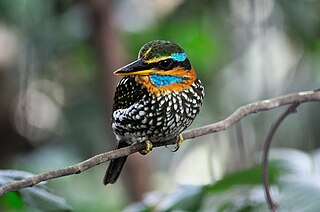
The spotted wood kingfisher or spotted kingfisher is a species of bird in the family Alcedinidae. It is endemic to the Philippines where its natural habitat is subtropical or tropical moist lowland forests.

The oriental dwarf kingfisher, also known as the black-backed kingfisher or three-toed kingfisher, is a pocket-sized bird in the family Alcedinidae. This tropical kingfisher is a partial migrant that is endemic across much of the Indian Subcontinent and Southeast Asia. It resides in lowland forests, typically near streams or ponds, where it feeds upon insects, spiders, worms, crabs, fish, frogs, and lizards. This small bird is easily distinguishable from other birds in its range due to its red bill, yellow-orange underparts, lilac-rufous upperparts, and blue-black back.

The Andaman drongo is a species of bird in the family Dicruridae. The species is endemic to the Andaman Islands of the Indian Ocean. There are two subspecies, the nominate race being found across the main islands of the archipelago, and the race dicruriformis occurring on Great Coco Island and Table Island in the north of the chain

The slaty-backed forktail is a species of forktail in the family Muscicapidae. A slim, medium-sized forktail, it is distinguished from similar species by its slate grey forehead, crown, and mantle. It has a long and deeply forked tail banded in black and white, a white rump, and a white bar across its primary feathers; the rest of the plumage is predominantly white. The sexes look alike. The bird frequents the edges of fast-flowing streams and rivers, where it hunts small invertebrates by hopping among rocks or flying out over the water. It breeds between February and July, laying 3–4 pinkish, bluish, or white eggs; both sexes incubate the eggs.

Archbold's newtonia is a species of bird in the family Vangidae. It is endemic to Madagascar. Its natural habitats are subtropical or tropical dry forests and subtropical or tropical dry shrubland. The birds have a greyish brown back and tail, with a rufous forecrown and a buffy white belly, throat, and undertail coverts. They have a conspicuous rufous eye-ring, accompanied with a black bill and pale yellow eyes. The species is sexually monomorphic, and there is no major difference between the sexes. There is no breeding plumage for the males.

The pale-footed swallow is a species of bird in the family Hirundinidae. It is found in the northern Andes, from Venezuela to Bolivia. It is monotypic.
The Mangareva kingfisher, also known as Tuamotu kingfisher, is a species of kingfisher in the family Alcedinidae, endemic to Niau in French Polynesia. It is classified as critically endangered.
